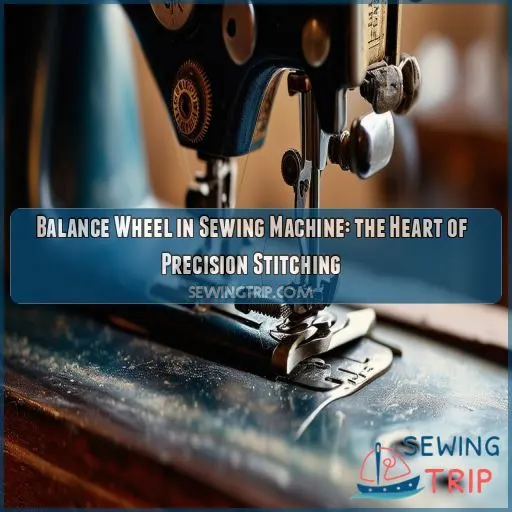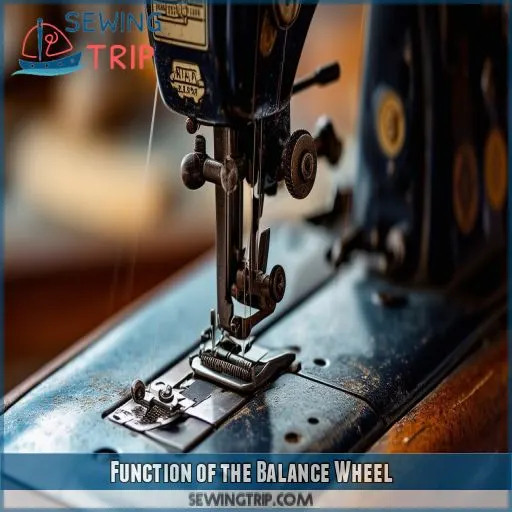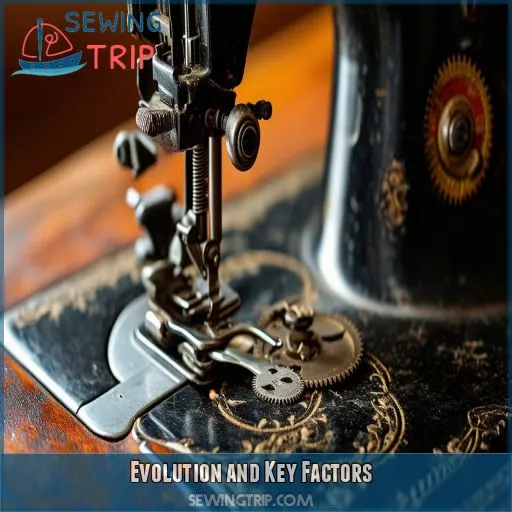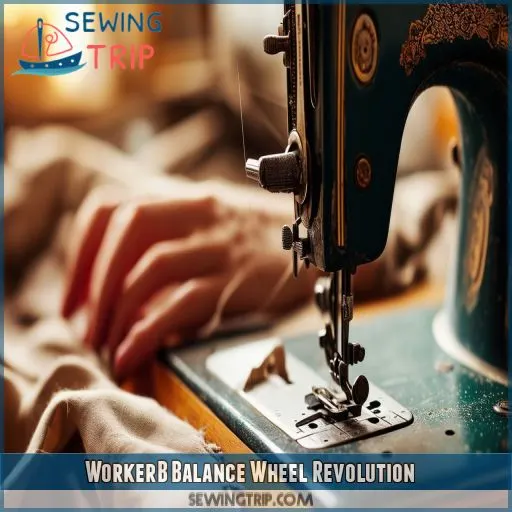This site is supported by our readers. We may earn a commission, at no cost to you, if you purchase through links.

You’ll use it to manually move the needle up and down, which is especially handy when threading or starting a seam. The balance wheel also helps control speed and reduce vibrations, making your sewing experience smoother.
Modern designs, like the WorkerB Balance Wheel, offer enhanced efficiency and control. Understanding this essential component will help you access your machine’s full potential.
Table Of Contents
Key Takeaways
- The balance wheel is the unsung hero of your sewing machine – it’s like the conductor of an orchestra, orchestrating the perfect dance between needle and hook to create those picture-perfect stitches. Who knew such a small wheel could have such a big job?
- Ever feel like your sewing projects are on a roller coaster? The balance wheel is your smooth operator, reducing vibrations and giving you more control than a Formula 1 driver. It’s the secret sauce to keeping your stitches straighter than an arrow.
- Talk about a multitasker! This nifty wheel doesn’t just look pretty – it’s the powerhouse behind your machine, transferring energy faster than a caffeinated squirrel. From manually moving the needle to controlling speed, it’s got more tricks up its sleeve than a magician.
- The evolution of balance wheels is like a tech race in the sewing world. From the beefy Power Plus to the sleek WorkerB, these wheels are pushing the boundaries of what’s possible. One stitch per second? That’s faster than you can say "bobbin"!
What is a Balance Wheel in Sewing Machine?
A balance wheel in a sewing machine is a circular component that rotates to drive the machine’s upper shaft, facilitating stitch production by moving the needle and hook. This essential part transfers power through the entire machine, acting as the heart of precision stitching and allowing seamstresses to control the sewing speed and direction.
Function of the Balance Wheel
Your sewing machine’s balance wheel is the powerhouse behind precise stitching. It rotates the upper drive shaft, moving the needle and hook to create stitches while transferring power throughout the entire machine.
Rotates the Upper Drive Shaft of a Sewing Machine
You’ll find the balance wheel at the heart of your sewing machine, tirelessly rotating the upper drive shaft. This mechanical part is essential for:
- Speed control and smooth operation
- Efficient power transfer throughout the machine
- Vibration reduction for precise stitching
As you turn the balance wheel, it aligns the shaft, transfers torque, and guarantees energy-efficient rotation. It’s like the conductor of an orchestra, setting the tempo for your sewing symphony. Master this wheel, and you’ll access your machine’s full potential.
Facilitates Stitch Production by Moving the Needle and Hook
As you rotate the balance wheel, it moves the needle and hook in perfect synchronization. This precision is essential for stitch formation.
The wheel’s movement controls needle precision, thread tension, and fabric movement. It’s the maestro of your machine, orchestrating the timing of each component.
With every turn, you’re creating up to 1,000 stitches per minute. It’s the heart of your industrial sewing machine, making every stitch count.
Transfers Power Through the Entire Machine
Your balance wheel isn’t just a pretty face; it’s the heart of precision stitching. As it rotates, it transfers power through your entire machine. This energy distribution is essential for smooth operation.
The wheel’s diameter and mass affect torque transmission, while its cogged construction guarantees drive efficiency.
With the WorkerB Power Pack, you’ll experience enhanced momentum and power distribution, taking your sewing to new heights.
Cogged Construction
The cogged construction of a balance wheel in your sewing machine provides slip-free power transfer, ensuring efficient operation. By eliminating the traditional friction belt-to-groove setup, this design offers a more reliable and precise sewing experience, allowing you to create consistent, high-quality stitches.
Provides Slip-free Power Transfer
You’ve seen how the balance wheel drives your sewing machine’s upper shaft. Now, let’s explore its cogged construction. This clever design guarantees slip-free power transfer, revolutionizing your sewing experience.
The cogs, like tiny teeth, grip a matching belt, optimizing torque and gear efficiency. This setup, found in modern machines like the Brother B755, outperforms the AC motors in antique sewing equipment.
You’ll notice reduced friction, minimal vibration, and enhanced belt durability. Whether you’re working on a delicate crafting project or tackling heavy-duty tasks, this cogged system provides the consistent power you need.
It’s a game-changer for precision stitching, giving you more control over your sewing adventures.
Eliminates Friction Belt-to-groove Setup for Reliable and Precise Sewing
You’ll love how the cogged construction of your sewing machine’s balance wheel revolutionizes your stitching experience. By eliminating the traditional friction belt-to-groove setup, this ultrafeed design guarantees:
- Smooth, whisper-quiet operation that’ll make you feel like you’re gliding on air
- Efficient power transfer that’ll have you zipping through projects in record time
- Minimal vibration, giving you precision control even at high speeds
- Simplified maintenance, so you can spend more time creating and less time tinkering
This dressmaking accessory is a game-changer, offering reliable and precise sewing like never before. With reduced friction and improved efficiency, you’ll find yourself in complete control, whether you’re using the hand crank or powering through with the motor.
Evolution and Key Factors
You’ll find that balance wheel evolution in sewing machines has centered on two key factors: diameter and mass. Larger diameters provide more power while smaller ones maintain speed, and heavier wheels like the Power Plus and Monster II offer increased momentum for better slow-speed control.
Focuses on Diameter and Mass
Regarding balance wheels, size significantly influences performance. The evolution of these essential components has focused on two primary factors: diameter and mass.
The diameter of the balance wheel directly affects your sewing machine’s power and speed. Larger diameters offer more force, while smaller ones maintain higher speeds.
Mass also plays a key role. The inertial effects and gyroscopic properties are paramount. Precise material selection and weight distribution are necessary for ideal rotational dynamics.
Heavier Balance Wheels Build Momentum for Slow-speed Control
You’ll find that heavier balance wheels offer distinct advantages for slow-speed control. These hefty components build momentum as they spin, providing a smoother, more consistent stitching experience.
The weight distribution plays a key role in torque generation, allowing you to maintain precise control over your machine’s speed. As you sew, you’ll notice the inertia effects at work, helping to stabilize the needle’s movement and reduce skipped stitches.
This enhanced stability is particularly beneficial if you’re tackling intricate patterns or working with delicate fabrics. By harnessing the power of a heavier balance wheel, you’re equipping yourself with a tool that’ll elevate your sewing game to new heights.
WorkerB Balance Wheel Revolution
The WorkerB Balance Wheel revolutionizes sewing with its ability to achieve an impressive rate of 1 stitch per second. You’ll appreciate its compatibility with the WorkerB Power Pack Motor System, offering an economical yet high-performance alternative for your sewing projects.
Enables Sewing at 1 Stitch Per Second
You’ve seen how balance wheels have evolved, but now let’s explore the game-changing WorkerB Balance Wheel. This revolutionary design takes speed precision to new heights, enabling you to sew at an astounding rate of 1 stitch per second. Imagine the efficiency you’ll gain!
With this level of stitch consistency, you’ll breeze through projects in no time. The WorkerB’s innovative design doesn’t just boost speed; it maintains excellent operator control across various fabric types.
You’ll find yourself tackling a wide range of materials with ease, from delicate silks to tough denims. Ready to experience machine efficiency like never before?
Compatible With the WorkerB Power Pack Motor System
You’ll be thrilled to know that the WorkerB Balance Wheel isn’t just about speed; it’s also a perfect match for the WorkerB Power Pack Motor System. This dynamic duo takes your sewing game to new heights.
The wheel’s design guarantees seamless motor compatibility, boosting power efficiency and giving you unparalleled speed control. Installation’s a breeze, with the wheel integrating smoothly into the system.
You’ll feel like a sewing wizard, effortlessly adjusting your pace from slow, precise stitches to lightning-fast seams. It’s like having a sports car engine in your sewing machine – responsive, powerful, and ready to tackle any project you throw at it.
Balance Wheel Options
You’ll find various balance wheel options for your sewing machine, each with unique characteristics. The Power Plus wheel offers robust power delivery despite being noisier, while Ultrafeed Sewing Machines are known for their cutting-edge balance wheel technology that provides unparalleled precision in stitching.
Power Plus Wheel: Noisier but Delivers Power
You’ll find the Power Plus wheel packs a punch, but it comes with a trade-off. While it’s noisier than other options, it delivers impressive power to your sewing machine.
The wheel’s design focuses on maximizing energy transfer, ensuring you’ve got the oomph needed for tough fabrics. Despite its robust performance, you might need to implement noise reduction techniques if you’re sensitive to sound.
The wheel’s speed control is excellent, allowing you to tackle intricate projects with precision. While vibration damping isn’t its strong suit, the power efficiency more than makes up for it.
It’s a workhorse that’ll keep your projects moving, even if it’s not the quietest kid on the block.
Ultrafeed Sewing Machines: Renowned for Industry-leading Balance Wheel Technology
You’ll find Ultrafeed Sewing Machines at the forefront of balance wheel technology. Their innovative design sets the standard for precision stitching, combining power efficiency with unmatched speed control.
These machines optimize performance, giving you the upper hand in your sewing projects. With Ultrafeed’s balance wheels, you’ll experience seamless power transfer and exceptional control, even at low speeds.
Whether you’re tackling thick materials or delicate fabrics, the industry-leading technology guarantees consistent results. You’ll appreciate the smooth operation and reduced vibration, making your sewing sessions more enjoyable.
Don’t settle for less in your craft – Ultrafeed’s balance wheel technology is your ticket to sewing mastery.
Frequently Asked Questions (FAQs)
What is the function of the balance wheel?
Yo, fam! Your sewing machine’s balance wheel isn’t just for show. It’s the MVP that rotates the upper drive shaft, making the needle and hook dance. You’ll control stitching speed and precision like a pro.
What does the wheel do on a sewing machine?
You’ll use the wheel on your sewing machine to control the needle’s movement. It lets you manually advance stitches, position the needle, and make precise adjustments. It’s essential for starting, ending, and fine-tuning your sewing projects.
What is the function of the hand wheel on a sewing machine?
You turn, you stitch, you control. The hand wheel‘s your precision partner, letting you manually advance the needle, adjust its position, and fine-tune your stitches. It’s your go-to for corners, darts, and delicate work.
How do you remove a balance wheel from a sewing machine?
To remove the balance wheel from a sewing machine, unscrew the retaining screw or clutch knob on the wheel’s center, then gently pull the wheel off the shaft. Use care to avoid damaging adjacent components.
What is a sewing balance wheel?
A balance wheel in a sewing machine directs energy to the needle and hook, ensuring smooth stitch formation. Impressively, advanced models like the WorkerB Balance Wheel can achieve sewing speeds of up to 1 stitch per second.
What does a balance wheel do?
A balance wheel in a sewing machine rotates the upper drive shaft, enabling needle and hook movement to produce stitches. It guarantees smooth power transfer, impacting overall performance and maintaining consistent needle operation.
Where is the balance wheel located on a sewing machine?
The balance wheel on a sewing machine is located at the upper right side. It’s crucial for manually controlling needle movement and stitch precision, crucial for tasks like turning corners and starting or ending seams.
What is a sewing machine wheel?
You’ll find the sewing machine wheel on the right side. It’s a circular component you turn to move the needle up and down manually. It’s essential for precise control and adjusting thread tension.
What is a handwheel in a sewing machine?
You’ve heard of it, but what’s the deal with a handwheel? It’s your sewing machine’s control center. Located on the right side, you’ll use it to manually move the needle up and down for precise stitching control.
Can a balance wheel be turned in the opposite direction?
You shouldn’t turn a balance wheel in the opposite direction. It’s designed to rotate one way for proper stitch formation. Reversing it can tangle threads, damage the machine, or create faulty stitches. Always follow the manufacturer’s instructions.
Can a balance wheel be replaced or upgraded?
Yes, you can replace or upgrade your balance wheel. It’s a straightforward process that’ll enhance your sewing machine’s performance. You’ll find various options available, from standard replacements to high-performance upgrades that’ll boost your machine’s power and speed.
How often should a balance wheel be maintained?
Did you know 90% of sewing machine issues stem from poor maintenance? You should clean and oil your balance wheel every 8-10 hours of use. Regular checks prevent wear, ensuring smooth operation and extending your machine’s lifespan.
Do different fabrics require different balance wheel settings?
You don’t need to adjust your balance wheel for different fabrics. It’s a constant part of your machine’s mechanics. However, you’ll want to adjust other settings like tension and stitch length to accommodate various materials you’re working with.
Can a damaged balance wheel affect stitch quality?
Damaged balance wheels definitely disrupt your stitching. You’ll notice uneven tension, skipped stitches, and poor fabric feeding. It’s important to check and maintain your balance wheel regularly to guarantee smooth operation and high-quality results in your sewing projects.
Are balance wheels universal across sewing machine brands?
No, balance wheels aren’t universal across sewing machine brands. You’ll find variations in size, design, and compatibility. It’s essential to use the correct balance wheel for your specific machine to maintain proper function and stitch quality.
Conclusion
Like the heart of a well-oiled machine, the balance wheel in a sewing machine is essential for precision stitching. You’ll find it’s more than just a circular component; it’s the key to smooth, controlled sewing.
Whether you’re using a traditional model or upgrading to a WorkerB Balance Wheel, understanding its function will elevate your sewing game.
From powering the upper drive shaft to enabling precise stitch control, this vital part guarantees your projects are executed with finesse.
Master your balance wheel, and you’ll access your machine’s full potential.











